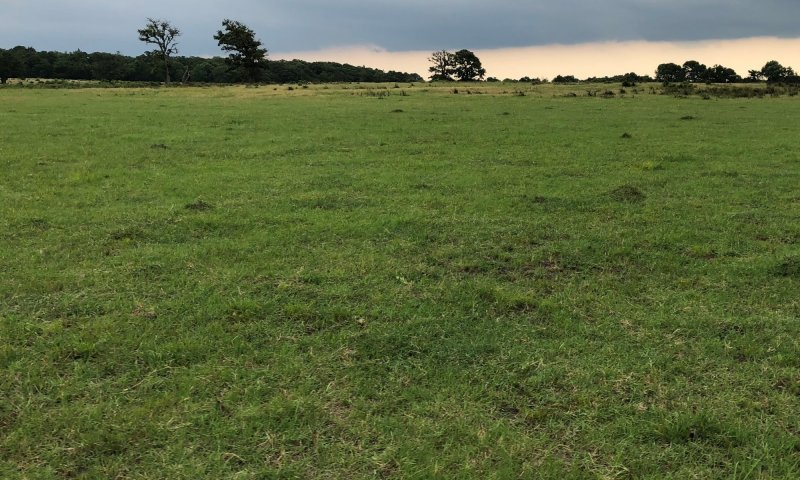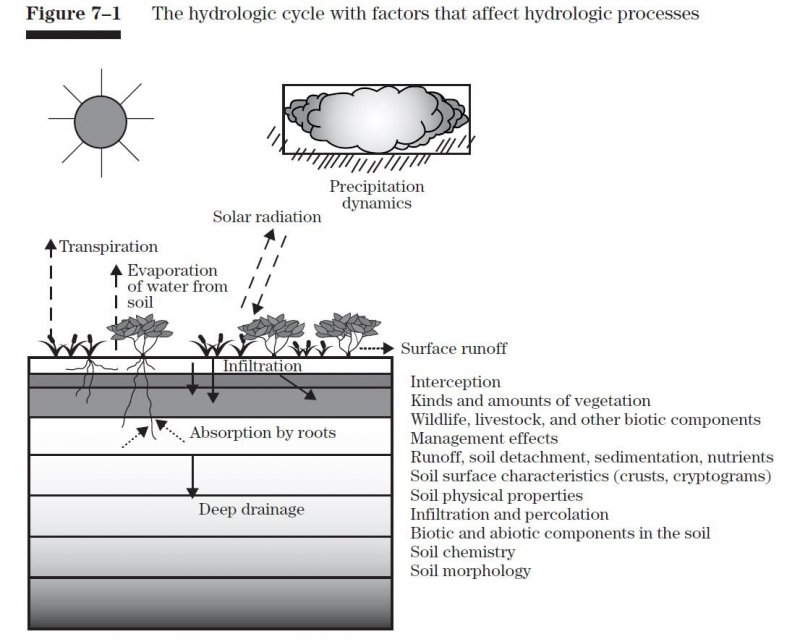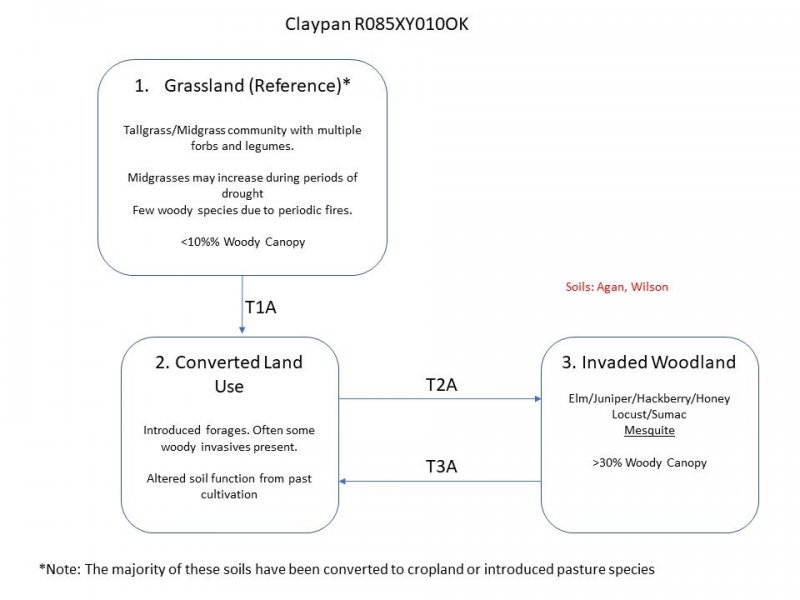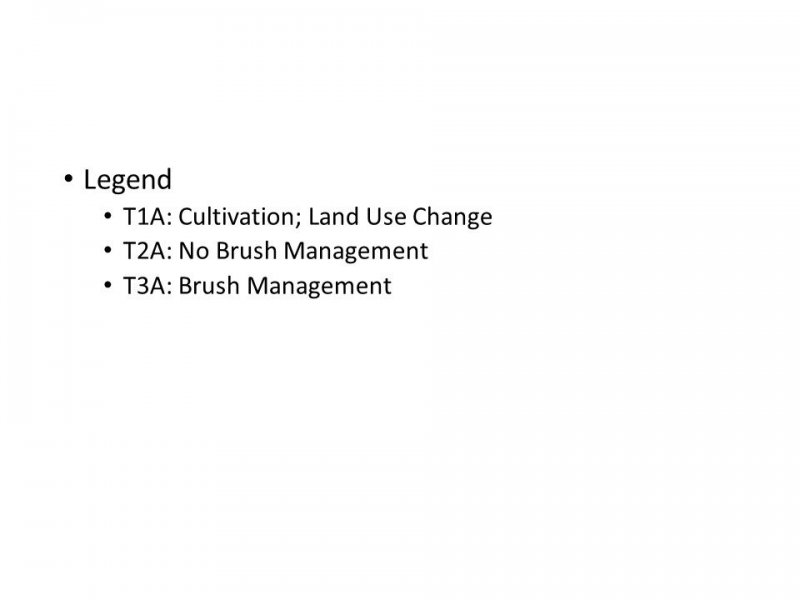Ecological dynamics
Like many sites across the Great Plains, changes in disturbance initiated by permanent settlements has had a profound impact on the ecological dynamics of these sites. Historically, the site was influenced by periodic fires during all seasons of growth. These fires were often the result of dry lightning strikes and/or anthropogenic fires set by Native Americans. The fire frequency during the period prior to settlement is estimated between 2-5 years for the southern Great Plains. These frequent fires were often followed by grazing of migratory bison herds attracted to the new growth of grass. This led to a shifting mosaic between burned/grazed and unburned and ungrazed landscapes.
With the removal of fire and the introduction of conventional livestock fencing, the landscape began to change to more homogenous vegetation patterns and altered plant communities. Gently sloping sites like the Claypan site were often broken out for crop production also. This led to a highly fragmented, highly disturbed landscape we see today across much of the area.
Less fire tolerant woody species are more prevalent in many areas due to fire suppression and/or the use of strictly dormant season fires. Abusive grazing can shift the plant community to less palatable grass species and lead to an increase in opportunistic forbs. Heavy grazing can also reduce fine fuel load and limit the ability to conduct a prescribed fire.
State and Transitional Pathways:
The following diagram suggests some pathways that vegetation on the site might take in response to various treatments or natural stimuli over time. There may be other states that are not shown on this diagram. This information identifies the changes in plant communities that do occur due to management practices and natural factors. The plant communities described here are commonly observed on this ecological site. The local NRCS field office has information available to assist with planning and development of the plant community for specific purposes.
Changes in plant community makeup may be due to many factors. Change may occur slowly or in some cases, fairly rapidly. As vegetative changes occur, certain thresholds are crossed. A threshold means that once a certain point is reached during the transition of one community to another, a return to the previous state may not be possible without the input of some form of energy. This often means intervention with practices that are not part of natural processes. An example might be the application of herbicide to control some woody species to reduce their population and encourage more grass and forbs growth. Merely adjusting grazing practices would probably not accomplish any significant change in a plant community once certain thresholds are crossed. The amount of energy required to effect change in community would depend on the present vegetative state and the desired change.
State 1
Grassland - Reference
This is the reference state for the Clay Upland ecological site. It represents the historic range of variability in the plant communities with the periodic disturbance of fire and grazing. It is dominated by herbaceous plants with few woody species.
The dominant grasses are big bluestem, Indiangrass, switchgrass and little bluestem. Other grasses include Texas cupgrass, sideoats grama, dropseeds, silver bluestem and Scribner’s panicum. Dominant forbs include Engelmann daisy, sunflowers, western ragweed, heath aster, poppymallows and pitcher sage. Legumes include wild indigo, yellow neptune, Illinois bundleflower, scurfpea, and native lespedezas. Few woody species persist in reference condition but may include sumacs, sand plum, coralberry, persimmon and blackberry. The Clay Upland site is estimated to produce between 2,000 – 5,000 pounds of vegetative production per year in reference condition.
Tallgrasses Midgrasses Forbs
Shrubs and Trees are a minor component of these sites.
Community 1.1
Table 5. Annual production by plant type
| Plant type |
Low
(lb/acre) |
Representative value
(lb/acre) |
High
(lb/acre) |
| Grass/Grasslike |
1700 |
2550 |
4250 |
| Forb |
200 |
300 |
500 |
| Shrub/Vine |
80 |
120 |
200 |
| Tree |
20 |
30 |
50 |
| Total |
2000 |
3000 |
5000 |
State 2
Converted Land Use

Figure 10. Agan soils. Johnston County, OK
This state represents a change in land use from rangeland to pastureland. The soil structure and biology has been altered and the site is dominated by introduced species. Management of introduced forages requires more inputs than native grasses. Careful consideration should be taken prior to planting to ensure the result meets the desired use. Ratings for forage yields can be found under the non-irrigated crop yield section in web soil survey. As with any fertility management program, current soil tests should be taken before planting and subsequent fertilization of introduced pastures.
The most common forage species on these sites include Bermudagrass and Old World Bluestems(eg. KR Bluestem).
Without brush management, woody species such as mesquites, junipers, elms, or honey locust may invade these sites.
There may be opportunities to plant native grass species on these sites to restore the reference plant communities. The success of this type of restoration is highly variable and depends on the remaining soil resources and past management. This type of endeavor often requires site specific planning and evaluation. However, the species described in the reference state are a good resource for initial planning of any restoration project.
State 3
Invaded Woodland
This state describes the invaded, woody dominated plant community of the Claypan site. The ecological processes are dominated by woody species including mesquite, honey locust, elm, and juniper species. Some herbaceous plants persist under the woody canopy or in interspaces. Usually, shade tolerant species like Texas wintergrass are prominent herbaceous components in this community. There may also be an increase in prickly pear in this state.
Transition T1A
State 1 to 2
Most of these sites were cultivated for crop production during the settlement of the area. Many of them have been planted to monocultures of introduced forage grasses in recent years. When these sites are cultivated, the soil properties are significantly altered from the reference state. Soil structure, hydrology and biology have been impacted and the site is transitioned to the Converted state.
Transition T2A
State 2 to 3
These sites are prone to invasion by juniper, mesquite and honey locust. Without brush management, brush invasion may increase to the point where the site transitions to the Invaded Woodland state. At this point it will take significant inputs to remove woody species and restore the grass dominated pasture.
Transition T3A
State 3 to 2
At this point it will take significant inputs to remove woody species and restore the grass dominated pasture. However, it may be achieved through brush management and a prescribed grazing plan which allows ample rest for the re-establishment of grasses.





